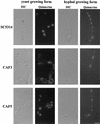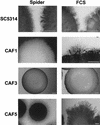Defective Hyphal induction of a Candida albicans phosphatidylinositol 3-phosphate 5-kinase null mutant on solid media does not lead to decreased virulence
- PMID: 12117957
- PMCID: PMC128189
- DOI: 10.1128/IAI.70.8.4462-4470.2002
Defective Hyphal induction of a Candida albicans phosphatidylinositol 3-phosphate 5-kinase null mutant on solid media does not lead to decreased virulence
Abstract
A phosphatidylinositol 3-phosphate [PI(3)P] 5-kinase gene (CaFAB1) of the most important human pathogenic yeast, Candida albicans, was cloned and sequenced. An open reading frame was detected which encodes a 2,369-amino-acid protein with a calculated molecular mass of 268 kDa and a relative isoelectric point of 6.76. This protein exhibits 38% overall amino acid sequence identity with Saccharomyces cerevisiae Fab1p. We localized the CaFAB1 gene on chromosome R. To determine the influence of the PI(3)P 5-kinase CaFab1p on processes involved in C. albicans morphogenesis and pathogenicity, we sequentially disrupted both copies of the gene. Homozygous deletion of C. albicans CaFAB1 resulted in a mutant strain which exhibited defects in morphogenesis. A Cafab1 null mutant had enlarged vacuoles, an acidification defect, and increased generation times and was unable to form hyphae on different solid media. The sensitivities to hyperosmotic and high-temperature stresses, adherence, and virulence compared to those of wild-type strain SC5314 were not affected.
Figures






References
-
- Altschul, S. F., W. Gish, W. Miller, E. W. Myers, and D. J. Lipmann. 1990. Basic local alignment search tool. J. Mol. Biol. 215:403-410. - PubMed
-
- Boeke, J. D., F. LaCroute, and G. R. Fink. 1984. A positive selection for mutants lacking orotidine-5′-phosphate decarboxylase activity in yeast: 5-fluoro-orotic acid resistance. Mol. Gen. Genet. 197:345-346. - PubMed
-
- Borg-von Zepelin, M., and T. Wagner. 1995. Fluorescence assay for the detection of adherent Candida yeasts to target cells in microtest plates. Mycoses 38:339-347. - PubMed
-
- Brown, A. J. P., and N. A. R. Gow. 1999. Regulatory networks controlling Candida albicans morphogenesis. Trends Microbiol. 7:333-338. - PubMed
MeSH terms
Substances
Associated data
- Actions
LinkOut - more resources
Full Text Sources
Molecular Biology Databases
Research Materials
Miscellaneous

